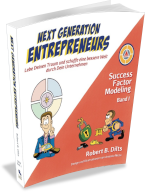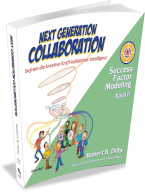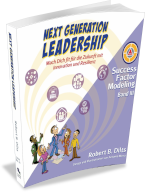NLP Podcast 77: Dr. Gudrun Reinschmidt - Silicon Valley - Success Factor Modeling for Entrepreneurs
In this podcast, Annemarie Freitag interviews NLP trainer Dr. Gudrun Reinschmidt from Nuremberg about her experiences regarding the topic of 'Success Factor Modeling'. Thank you very much for this interview, dear Gudrun.
Dr. Gudrun Reinschmidt attended the 'Success Factor Modeling' seminar by Robert B. Dilts in 2015 in Silicon Valley and was so enthusiastic about it that she wanted to bring this idea to Germany. This type of modeling was primarily developed for entrepreneurs in Silicon Valley who want to present themselves to investors to support their projects.
There are also 3 books on this topic in English, and Gudrun has translated 2 of the 3 into German.
The content of the books or seminars can be used by anyone who wants to become self-employed, position themselves, and of course, they are particularly suitable for start-ups creating their elevator pitch by learning how to develop a vision from their passion.
Gudrun started in marketing,
was responsible for sales, experienced production at several interfaces, and wanted to make her communication skills a bit easier with a coach. This coach was an NLP enthusiast and took Gudrun to an NLP group. After an NLP basic seminar, which was also at the beginning of her self-employment, she was so enthusiastic that she completed her NLP trainer training within 2 years.
Since 2003, she has attended various NLP seminars without knowing that the content was designed with NLP elements. The trainers were very good but never connected their program content with NLP.
Meanwhile, Dr. Gudrun Reinschmidt is now an NLP trainer herself.
Gudrun is so fascinated by Robert Dilts because he has a lot of experience with executives and also founded and led a communication institute for the Fiat Group. From these trainings, he developed many models for executives, combined with the integral approach of Ken Wilber.From this, he developed a systemic concept from which founders, entrepreneurs, executives, and engaged employees can learn a lot.
Next Generation Entrepreneur
Volume 1: Next Generation Entrepreneur, with the German subtitle ‘Live Your Dream and Create a Better World Through Your Business’, is also something for intrapreneurs, for those who want and should be entrepreneurs within a company. For example, for product managers or project leaders.
Volume 2: Next Generation Collaboration, with the German subtitle ‘Free the Creative Power of Collective Intelligence’, which is really about co-creating. It’s about people coming together and creating something they wouldn’t be able to achieve alone. That is exactly co-creation.  When I develop something myself, of which I didn’t know I was capable. It is important that everyone involved sees themselves as equally important to the team. Everyone must fully engage. No one should hold back because they might want to withhold information. The team is only as strong as its weakest link. Here are many methods that Robert uses in his mastermind groups, utilizing the morphogenetic field, as it generates a collective intelligence, a higher mind, from which ideas are then drawn. The so-called field spirit by Dilts is utilized.
When I develop something myself, of which I didn’t know I was capable. It is important that everyone involved sees themselves as equally important to the team. Everyone must fully engage. No one should hold back because they might want to withhold information. The team is only as strong as its weakest link. Here are many methods that Robert uses in his mastermind groups, utilizing the morphogenetic field, as it generates a collective intelligence, a higher mind, from which ideas are then drawn. The so-called field spirit by Dilts is utilized. In Volume 3 it is about Conscious Leadership, Leading with Awareness.This is not yet available in German. The awareness that not only the financial success of a company is important but also the sustainability and future viability of a business. This volume, with the German subtitle ‘Get Fit for the Future with Innovation and Resilience’ is aimed explicitly at executives.
In Volume 3 it is about Conscious Leadership, Leading with Awareness.This is not yet available in German. The awareness that not only the financial success of a company is important but also the sustainability and future viability of a business. This volume, with the German subtitle ‘Get Fit for the Future with Innovation and Resilience’ is aimed explicitly at executives.
‘What do the new entrepreneurs gain from engaging with Next Generation Entrepreneur?’
Here, very successful entrepreneurs, the game changers, were analyzed to see what they all have in common. Dilts developed a model from this, the SFM Success Circle. You should therefore fulfill the following points to establish a successful business:
- You need passion, something you want to commit to long-term
- Clarity, which customers do you want to work with?
- From this, your vision emerges
- Ask yourself, what goals do you want for yourself personally, what do you want to pursue ambitiously?
- From this, your ambition emerges
- Only when your vision and your ambition come together does a truly promising, sustainable business emerge.
For example, the founding of the Grameen Bank, the bank from Bangladesh, which provides microloans to people without income security.
The founder and economist Muhammad Yunus himself described the situation as follows:
‘I saw that people were working hard. But still, they remained poor. Why? They told me it was because they had no capital. To purchase materials for making simple furniture or ingredients for the food they cooked and sold on the street, they had to borrow money: either from those who provided them with the raw materials and then paid them for the finished products, or from the moneylender who charged exorbitant interest. Either way, by the end of a long workday, they had hardly anything left.’
‘More than 98% of the first loans, often less than 50 dollars, were repaid. Additionally, members had to commit to opening and regularly maintaining a savings account with Grameen Bank,’ reports Wikipedia.A great why and a very viable business model.
Another example, if I have the vision of ‘bringing NLP for parents and children together into the world’, I should first ask myself:
- Why do I really want this?
- Do I prefer to work with children or with parents?
- What do I want to achieve from this work myself?
- Then I need a good understanding of what exactly my own contribution is, my mission in this big vision?
- Then I should be very clear about my role, what I am particularly good at, where I am unique and exceptional, where my peak performance area is, and what I can expect from other partners. Only when I know my own area well can I also differentiate myself from others and then cooperate again.
- If everything aligns, the business will be a success.
So people who are seemingly competitors can work well together according to this idea of co-creation. They can complement each other, seeing where they can benefit from one another.
In Silicon Valley, it is quite common for those who are thinking about starting a business, growing, or developing a business idea to reflect on these ideas repeatedly with like-minded individuals. Even with those who are seemingly their competitors. This leads to better ideas, newer, or even richer ideas.
This is exactly the concept in these trainings for the "Next Generation Entrepreneur," where those who want to become self-employed help each other refine their vision, become fully aware of their ambition, passion, mission, and role.
Aren't the supposed competitors taking customers away from each other?
The clear answer: NO. No company can make all people happy. Especially among trainers and coaches, each is so unique that everyone attracts the customers that fit them. There are enough customers out there, and there is still a lot of room for growth.
A significant effect of Success Factor Modeling is the sponsorship, where I address and appreciate people on their identity level. To give an example, in an exercise, you would stand in the middle and say: "My task is to bring NLP to children and parents together into the world." Then you would receive appreciation and recognition from others, this sponsorship from all sides, from all participants. You would feel firsthand: "Yes, it is important to me, I am the right one for this, I am capable, I can do this, and that it is truly desirable for me to implement this and, above all, that I deserve it."
Robert Dilts has outlined why people often doubt themselves:
- They believe that something is not possible
- They believe that they are not worth it
- They believe that they simply cannot do it
- They believe that they are insignificant
- They believe that what they do has no special value for the world
The first book is a workbook; it contains many interesting colorful images and drawings by the illustrator, cartoon artist, and visual storytelling graphic facilitator Antonio Meza, who collaborates with Robert. Everything described in the book is also illustrated, with many case studies and numerous exercises and forms that can be done alone or in groups.<
Gudrun's vision is to incorporate this optimism that can be learned from these books by these game changers into the German-speaking area. People should go to work with joy so that they can also contribute profitably to the company because they see a purpose in their work.
With a respectful attitude towards their own employees, the supervisor inspires their employees to be more productive. Some customers have already written and published a book during a seminar.
3 final tips from Gudrun for our blog readers and podcast listeners:
- Interview with Robert Dilts in English, which you can also find on Gudrun's homepage.
- This is how you can quickly become the best version of yourself, in the COACH State:
- C – centered /zentriert. You clarify how you can center yourself as much as possible. For example, sitting upright, feet on the ground, being aware of your body and breath, and over time directing your energy into your belly and really telling yourself: "I am present and fully here"
- O – open / offen. And then you feel into your heart and say: "I am open, I am very curious about what is coming".
- A – aware / bewusst and attentive, you then direct your focus to your head, to say: "I am attentive, fully awake".
- C – connected / verbunden, you then feel connected with your belly, heart, head, and the whole system around you. You feel that you are part of this universe. And when you feel this connection, which plays a very important role in these spiritual teachings, you can also let go and remain calm.
- H – holding / halten. Then you are ready to hold whatever comes, no matter what emotion or stress comes your way.
If you start to enter the COACH State in the morning, you can face the day with calmness.
NLP Podcast 77: Dr. Gudrun Reinschmidt - Silicon Valley - Success Factor Modeling for Entrepreneurs
Discover the basics of NLP and learn more – tune in now.







